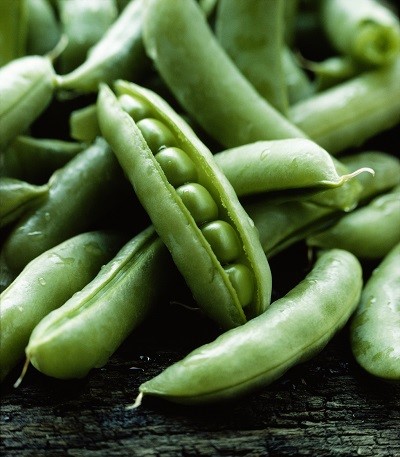
The florists’ calendar marks April with sweet pea, a pretty, non-edible plant with the unwieldy name Lathyrus odoratus. The cooks’ calendar gets hopping around April with sweet peas too, only these are Pisum sativum. Not to be confused with their floral counterparts, sweet garden peas are delicious and a great introduction to the spring vegetable harvest.
Geniuses, in fields as diverse as science, statecraft, gastronomy and literature have all had passions for the tiny pea. Gregor Mendel birthed a field of genetics based on his observations of pea pods. Thomas Jefferson was an aficionado as well; over 30 varieties grew at Monticello. M.F.K. Fisher, writer and gourmand, called peas “delicate messengers to our palates from the kind earth,” in An Alphabet for Gourmets.
Despite, or maybe due to, their delicacy and the necessity of shelling, green peas are popular from the freezer case or can. However, fresh garden peas are a treasure worth the effort of shelling, which can be worthwhile and meditative work for idle or hungry hands. Frozen and canned peas certainly have their places, particularly if they are preserved at the peak of their season but fresh from the garden, peas embody the flavor of new spring warmth.
Taller pea varieties have experienced a bit of a decline in popularity, but their production can be unrivaled. Varieties such as Green Arrow and British Wonder require some support but can be managed easily in limited spaces. These can be trained to grow along fences, trellises, and single stakes or along a net. Gardeners without much room can still see a plump harvest from dwarf or indeterminate varieties like Little Marvel, a popular heirloom variety that tops out at 15-20 inches of height per plant. Varieties including Alaska, Daybreak, and Spring offer shorter growing times and earlier harvest for the impatient culinary gardener.
Recipes for peas differ nearly as much as the cultures that enjoy them. Swedish pea soup, for example, predates the Viking era, and reflects the culture’s need for and use of a cool weather, short season vegetable. Chinese cooks, on the other hand, make use of pea sprouts, shoots and leaves in addition to the peas themselves. Peas appear in grain dishes, stews, salads and more, seasoned according to the recipe’s origin.
Pea salad recipes proliferate, involving such ingredients as mint, bacon, dill, cashew and jicama. Many have a creamy base for the dressing, whether yogurt, crème fraiche or mayonnaise; however, a few feature vinaigrette or citrus dressings. Most are garnished with toasted cashews, peanuts or sunflower seeds, which belie these preparations’ distinctly American origins. Warm preparations pair peas with cauliflower, homestead cheese, potatoes, rice, pasta, chicken and tofu.
Should the harvest exceed one’s ability to cook and eat it all, the ubiquity of commercially available preserved peas speaks to the ease of preserving them at the height of their flavor. A very brief boil, followed by a plunge into icy water, then thorough draining gets peas ready to be frozen. An easy way to prevent an iceberg studded with green peas, and therefore to allow for the later use of smaller portions is to spread drained peas in a single layer on a sheet of wax paper lining a shallow pan, like a jelly roll pan or a cookie sheet. Place the peas in the freezer, flat and once they have frozen, they are ready to be put into bags, plastic containers, or other labeled freezer organization system. These frozen peas will have a great deal of the flavor of fresh but will not quite match garden-fresh. Preparations for preserving peas can be obtained from county extension services; if canning, be sure to use a modern recipe and thoroughly clean equipment.
Fresh peas are the only choice for this method, adapted from M.F.K. Fisher’s breathless paean to peas. According to Fisher, the peas must be very green, freshly gathered and shelled immediately before preparation. A good handful of peas for each person eating should be prepared and diners can be enlisted to pick and shell peas. In a good, heavy pot, bring about half an inch of water to a quick boil. Add rinsed, freshly shelled peas, and cover quickly. The peas will steam for two short minutes, then shake the pot and allow peas to steam another minute. At this point, check for doneness – peas should be tender, but not mushy. Add fresh butter, salt, and fresh ground pepper to taste, and serve immediately.
Amy Ambrosius is a writer and budding gardener living deep in the heart of Texas with her family.
Related Articles & Free Email Newsletter
How to Grow and Prepare Lima Beans
Planning and Designing a Productive Vegetable Garden



Comment here